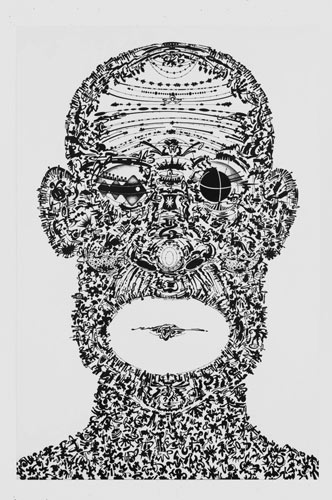
Mark Steven Greenfield’s incisive automatic drawings in his “Doo Dahz” series continue his intense exploration of the minstrel in blackface and its accompanying prejudicial symbols. The implications of the minstrel in black face in American culture are summed up in potent portraits that reveal the rampant exploitation, racism and stereotyping encased in this musical format. Greenfield adds depth and poignancy to his portraits of well-known minstrels, who are both black and white, through his concise drawing. By selecting a musical tradition that is fraught with complexity and mirrors race relations at the time, Greenfield artistically parlays the many layers of the image of the minstrel, delving into the white performers and later on black performers who exaggerated and appropriated ideas from black culture that helped to institute inbred caricatures and stereotypes.
In “Portrait of George Walker,” a black performer in blackface, the symbolic face of the minstrel is filled with squiggles and marks completely covering the surface. The hair, eyes and forehead are filled with dense lines and patterns. In addition to the rich social content, Greenfield’s equal mastery of form is readily apparent in the rhythmic shapes that play across Walker’s face, each serpentine mark combining to make the whole dynamic. The eyes are a form of op art, with a zigzag line intersecting the pupil to produce a dazzling image. The portrait is both anonymous and individual, the blackface becoming a mask that both mirrors the emotions and hides them. George Walker was a talented late 19th century African American minstrel who, with his partner Bert Williams, called themselves “The Two Real Coons,” and produced the first musical with an all black cast. In both minstrel and vaudeville acts, the duo popularized the “cakewalk,” a dance based on a West African festive dance. How ironic that this brilliant performer had to cover his own dark skin with the stereotypical blackface. The tiered complexities of this masquerade are what Greenfield alludes to throughout the exhibition.
Greenfield’s marvelous “Portrait of Rosetta Duncan” is powerful in all aspects. Using a target for one of her eyes and the other eye crossed out, she appears to be a clown, with a ruff as her collar, her face conforming to blackface tropes. Filled with a dense web of lines, the surface vibrates with a myriad of patterns that fit together like a puzzle. Rosetta Duncan and her sister were white vaudevillians that were famous for their portrayal of Topsy and Eva from Uncle Tom’s Cabin. Rosetta was in black face and played Topsy to her sister’s blond Eva. In this amazing portrait, the white performer becomes submerged under the black stereotype, and she becomes a convincing buffoon.
“Portrait of Dan Bryant” is a complex linear mosaic with every conceivable shape covering its surface, from spirals to dashes. Bryant’s eyes are akimbo and the hair resembles a black and white honeycomb. Bryant was another early white minstrel player in black face. Like Greenfield’s portrait of Rosetta Duncan, his face becomes distorted under the dense mass of rhythmic ink lines that completely overtake his own personality.
Greenfield’s strong series of pen and ink minstrel portraits are intricate and segue directly into his group of poetic and more abstract drawings, which feature ghostly images of minstrel players juxtaposed with typical icons of their trade - like gloves, the hat and the black face floating in a delicately delineated space. Bunches of cotton float in many of the works, like clouds through the atmospheric surfaces, with fragile lines hinting at the silhouettes of the performers. The lyrical structure and luminous colors of these drawings belie their potent subject matter, in direct contrast to the full frame, dynamic ink portraits.
Published courtesy of ArtSceneCal ©2011
